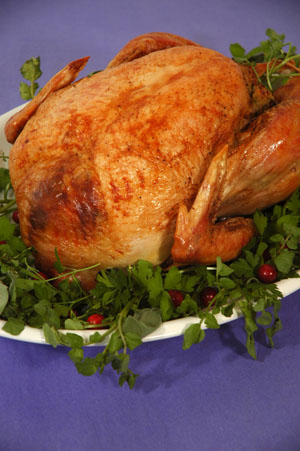
Roasting a perfectly moist holiday bird takes attention to detail and a little heavy lifting, but the process isn’t difficult. Just follow the steps below, and be sure to allow the meat to rest for half an hour before carving.

| 1 | 10–12-pound | brined turkey |
| 1 1/2 | teaspoons | freshly ground black pepper |
| 4 | ounces (1 stick) |
unsalted butter |
| 1 | recipe | stuffing |
Preparing the Bird:
1. One hour before roasting the turkey, remove it from the brine and rinse in cool water.
2. Blot dry inside and out with paper towels. Discard brine.
3. Allow the turkey to rest at room temperature for one hour. Use this time to preheat the oven to 425 degrees F. Adjust oven rack to lowest position necessary to accommodate the turkey.
4. Generously spray a roasting pan and rack with vegetable oil cooking spray.*
5. Lightly sprinkle turkey inside and out with black pepper.
6. Lightly pack the stuffing into the carcass through both openings, leaving enough loose skin at either end to close up the openings.
7. Secure the openings by weaving the skin together with metal poultry skewers.
*If you do not want to invest in a roasting pan, use two heavy-duty disposable pans stacked together for extra support.
NOTE: To prevent the possible growth of bacteria, never refrigerate a stuffed turkey either before or after roasting.
Roasting:
1. Place the stuffed turkey on a rack in the roasting pan, breast-side up.
2. Melt butter in a 2-quart saucepan.
3. Cut a piece of cheesecloth as long as the turkey. Unfold cheesecloth completely, then fold it in half to create a double-layer sheet.
4. Dip cheesecloth into the melted butter. Allow the cloth to completely absorb all the butter.
5. Arrange the soaked double layer of cheesecloth over the surface of the turkey, covering as much of the bird as possible. Drizzle any remaining melted butter onto the cheesecloth.
6. Insert an ovenproof thermometer into the densest part of a thigh, where the thigh meets the carcass, not touching the bone. (This step is optional.)
7. Place turkey into the preheated 425-degree oven and roast for 30 minutes.
8. After 30 minutes, lower heat to 325 degrees. Calculate remaining cooking time as follows:
The traditional roasting rule is 15 minutes per pound, plus 30 minutes for the stuffing. For this recipe, perform the above calculation, then subtract 75 minutes for the time the bird has already spent in the oven at high temperature (and to build in a fudge factor). Set a timer. Every half hour or so, peek to be sure the cheesecloth isn't getting too dark. When the cheesecloth becomes very dark brown, remove the turkey from the oven and gently peel the cloth away. Return to the oven and continue roasting.
9. When timer rings, remove the turkey from the oven and check the temperature in thickest part of each thigh. The turkey is done when both thighs register 175 degrees. Be sure to insert the thermometer deep into the thigh where it meets the hip, without touching the bone. If the breast is getting too brown before the thighs are done, cover the breast only with a loose tent of aluminum foil.
10. When the turkey is done, transfer the rack and turkey to a heavy, rimmed baking sheet.
11. Carefully remove and discard the cheesecloth if you haven’t already done so.
12. Tent turkey loosely with foil and let rest in a warm place for 30 minutes while you make the pan gravy. This resting period allows the juices to be absorbed back into the meat.
13. In the turned-off oven, warm a serving platter, a large bowl for stuffing, and a gravy boat or bowl.
Serving:
1. At serving time, carve the turkey and place slices on warm platter, slightly overlapping to keep them warm and moist. Remove metal skewers and spoon stuffing into the warm bowl. Reheat gravy, if necessary, and transfer to a warm gravy boat or bowl.
2. Store any leftover gravy, covered, in the refrigerator, and use any remaining turkey broth, carving juices, or water to thin the gravy when you reheat it.
NOTE: When you carve the bird, don't be surprised if you detect a very slight pink tinge in the breast meat. As with pink hams, the color is a byproduct of brining.


